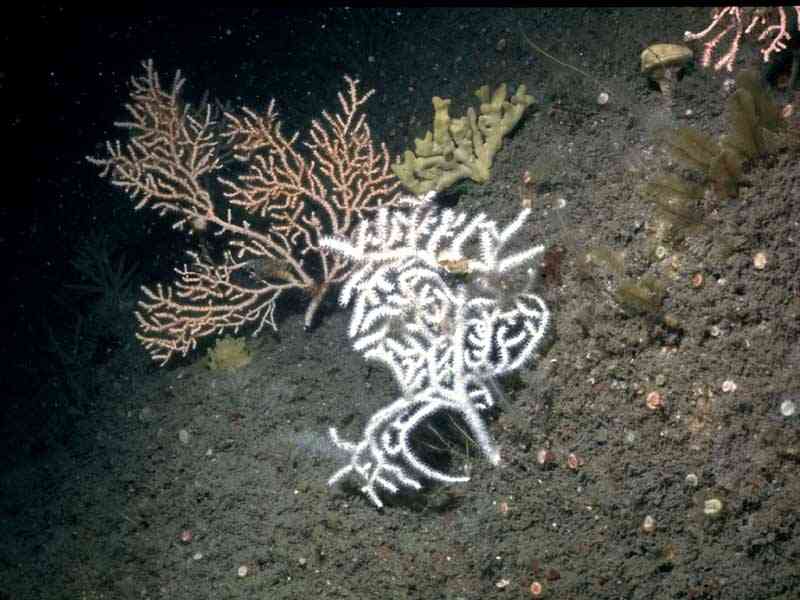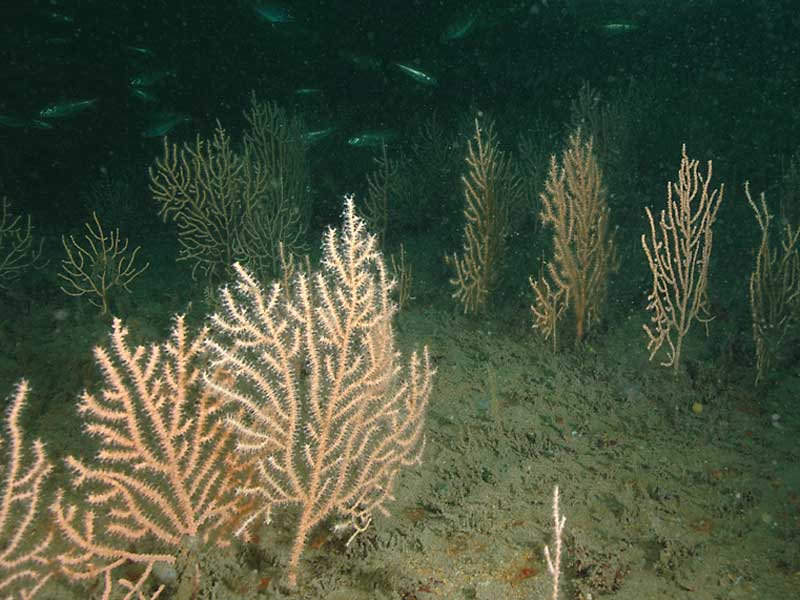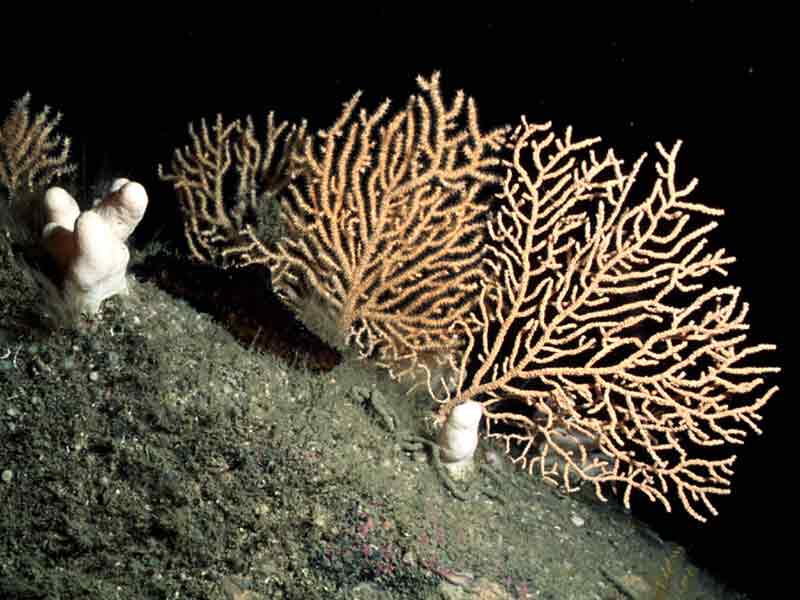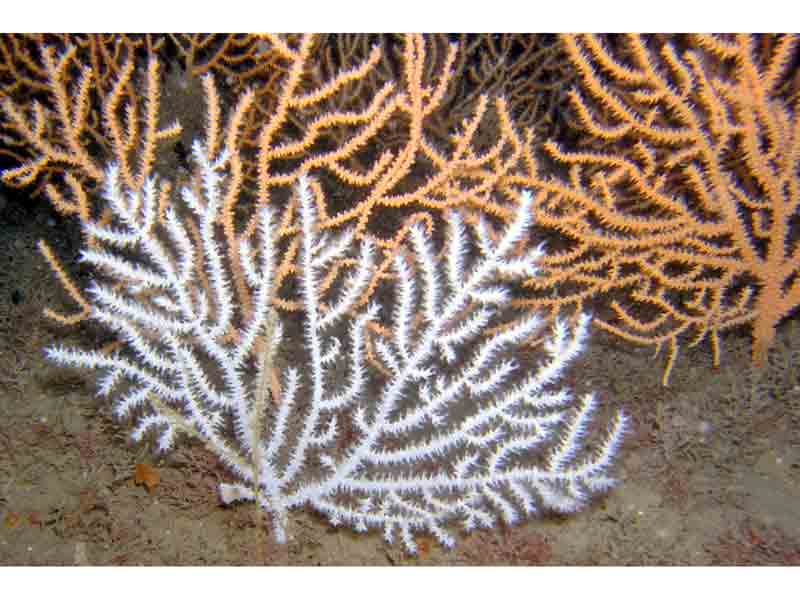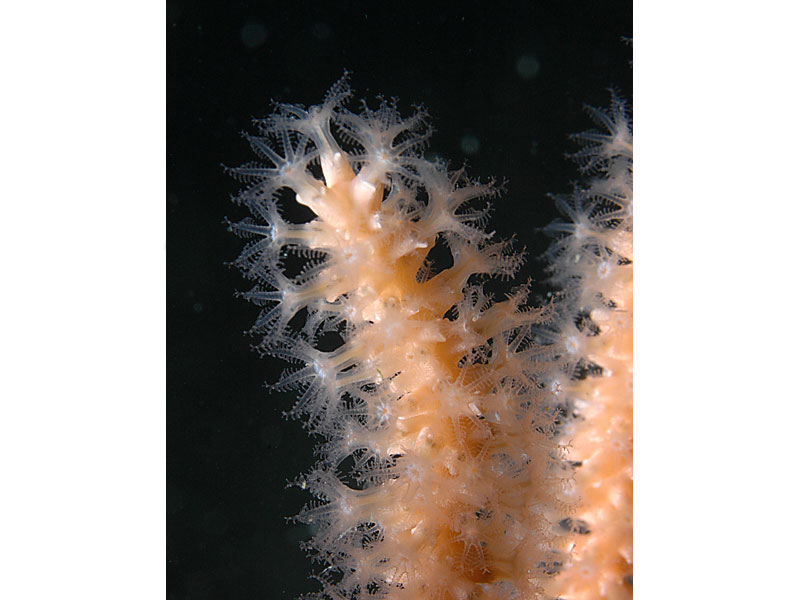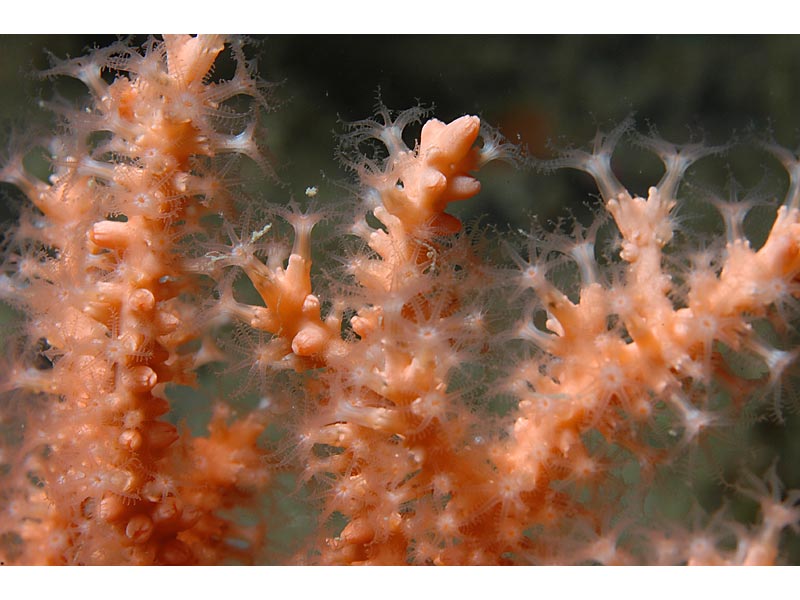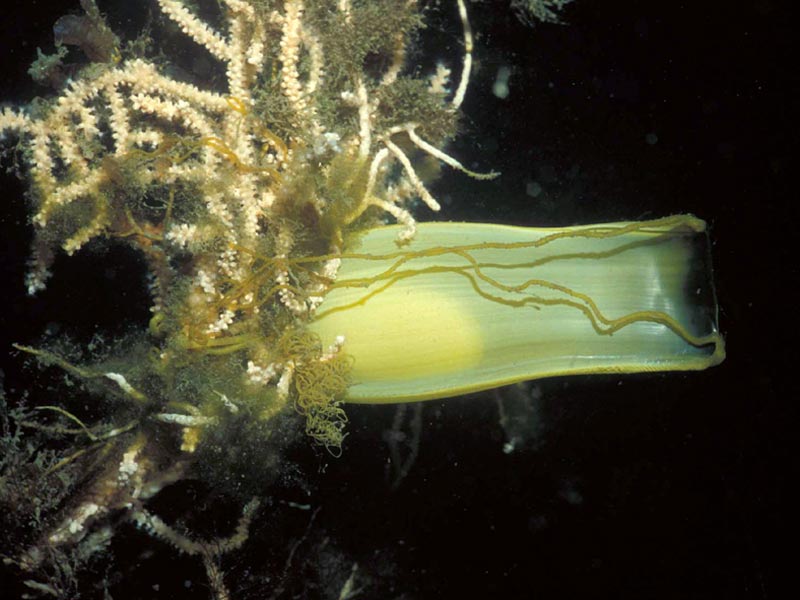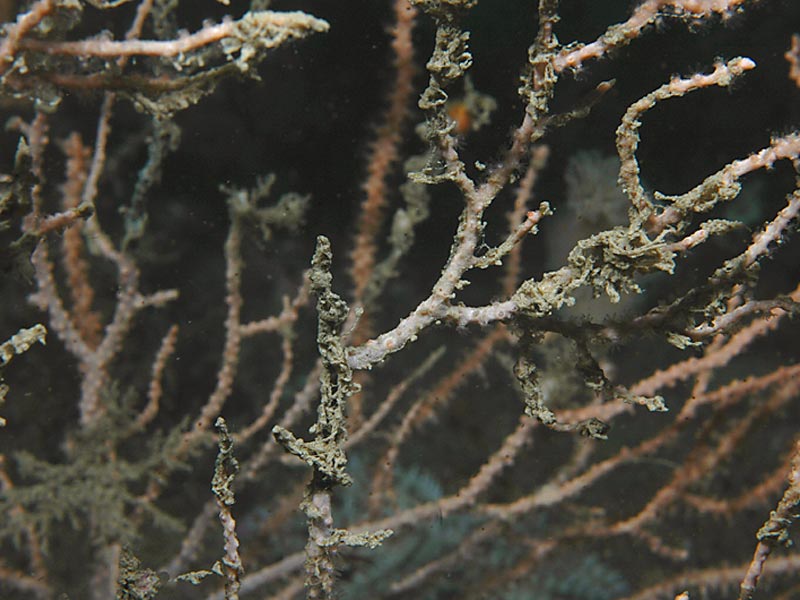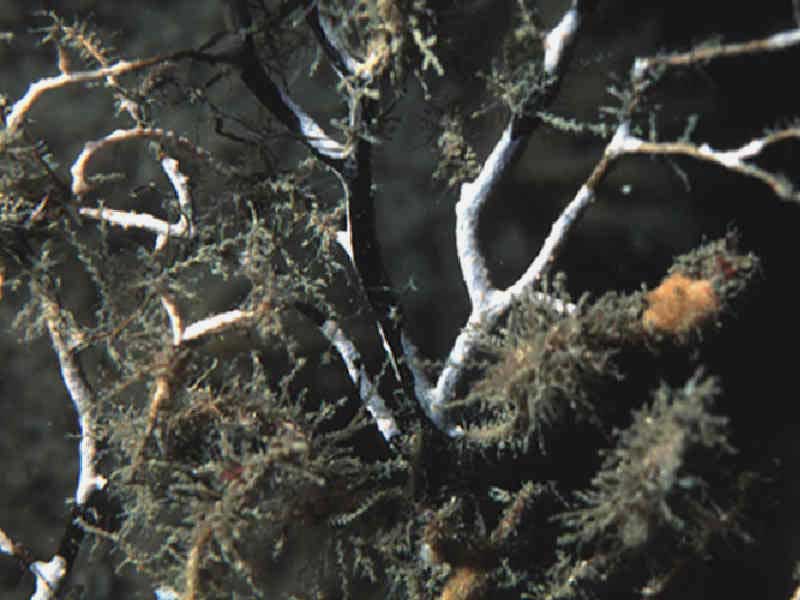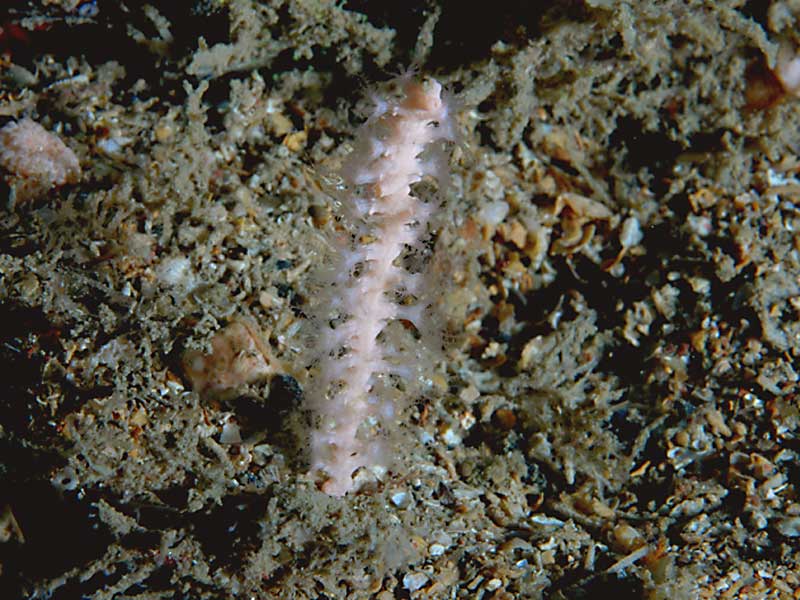Pink sea fan (Eunicella verrucosa)
Distribution data supplied by the Ocean Biodiversity Information System (OBIS). To interrogate UK data visit the NBN Atlas.Map Help
| Researched by | John Readman & Dr Keith Hiscock | Refereed by | This information is not refereed |
| Authority | (Pallas, 1766) | ||
| Other common names | - | Synonyms | - |
Summary
Description
Eunicella verrucosa is an erect colonial gorgonian that varies from white to deep pink in colour. Colonies branch profusely and the branches are covered in warty protuberences from which the small anemone-like polyps emerge. Colonies may be up to 50 cm high but more often up to 25 cm and are usually oriented in one plane (at right angles to the prevailing water currents).
Recorded distribution in Britain and Ireland
Recorded northwards to north Pembrokeshire and eastwards to Portland Bill in Britain. Common in parts of south Devon and Cornwall, the Isles of Scilly, and at Lundy. Present on the south and west coasts of Ireland but common only in Galway and Donegal Bays.
Global distribution
South and west coasts of Britain and Ireland south to north-west Africa and present in the western Mediterranean (Carpine, 1975; Manuel, 1988).
Habitat
Found mainly on upward facing bedrock in areas where water movement (wave action or tidal streams) is moderately strong.
Depth range
4->50 mIdentifying features
- Profusely branching fan-shaped colonies with close-set polyps on warty protuberences (calyces).
- Sclerites are warty spindles in the inner coenenchyme and balloon-club shaped in the outer.
- Height up to 50 cm.
- Colour varies from white to deep orange-pink.
Additional information
May be confused with Swiftia pallida, which occurs in Scotland northwards to Scandinavia but is much less branched, has generally thinner branches and may be white or rose coloured.
Listed by
Biology review
Taxonomy
| Level | Scientific name | Common name |
|---|---|---|
| Phylum | Cnidaria | Sea anemones, corals, sea firs & jellyfish |
| Class | Anthozoa | Sea anemones, soft & cup corals, sea pens & sea pansies |
| Order | Alcyonacea | |
| Family | Gorgoniidae | |
| Genus | Eunicella | |
| Authority | (Pallas, 1766) | |
| Recent Synonyms | ||
Biology
| Parameter | Data | ||
|---|---|---|---|
| Typical abundance | Moderate density | ||
| Male size range | 25-50 cm | ||
| Male size at maturity | |||
| Female size range | 25-50 cm | ||
| Female size at maturity | |||
| Growth form | Arborescent / Arbuscular | ||
| Growth rate | 1 cm/year | ||
| Body flexibility | High (greater than 45 degrees) | ||
| Mobility | Sessile, permanent attachment | ||
| Characteristic feeding method | Passive suspension feeder | ||
| Diet/food source | Omnivore | ||
| Typically feeds on | Suspended matter including plankton | ||
| Sociability | Colonial | ||
| Environmental position | Epibenthic, Epilithic | ||
| Dependency | Independent. | ||
| Supports | Substratum Tritonia nilsohdneri, Amphianthus dohrnii, Simnia patula | ||
| Is the species harmful? | No | ||
Biology information
The age of Eunicella verrucosa colonies can be determined (destructively) from growth rings in the axis. There is one growth ring per annum as evidenced by studies that measured growth rate in marked fans and then harvested the sea fans to count growth rings (Keith Hiscock, unpublished studies). Growth rate can be highly variable with an increase in branch length of up to 6 cm in some branches in one year and virtually none in others in Lyme Bay populations (C. Munro, pers. comm.) in one year. About 1 cm per annum increase in branch length was recorded in marked colonies at Lundy corresponding to measures of branch length correlated with the number of annual growth rings (Hiscock, unpublished studies).
The sea fan anemone Amphianthus dohrnii specifically lives on sea fans. The sea slug Tritonia nilsohdneri feeds on sea fans and is camouflaged to look like the sea fan. The 'poached egg shell' Simnia patula feeds on sea fans and observations at Lundy (K. Hiscock, R. Irving pers. comm.) suggest that their egg laying might cause mortality. Other species colonize damaged or partially dead sea fans where the coenenchyme has been lost, especially barnacles, bryozoans and ascidians.
Habitat preferences
| Parameter | Data |
|---|---|
| Physiographic preferences | Offshore seabed, Open coast, Strait or Sound |
| Biological zone preferences | Lower circalittoral, Upper circalittoral |
| Substratum / habitat preferences | Artificial (man-made), Bedrock, Large to very large boulders |
| Tidal strength preferences | Moderately strong 1 to 3 knots (0.5-1.5 m/sec.) |
| Wave exposure preferences | Exposed, Moderately exposed, Sheltered, Very exposed |
| Salinity preferences | Full (30-40 psu) |
| Depth range | 4->50 m |
| Other preferences | Found mainly on upward facing rock but occasionally on vertical surfaces. |
| Migration Pattern | Non-migratory or resident, Not relevant |
Habitat Information
Older records suggest that the species occurred in the English Channel almost to the Thames Estuary (Margate). It may occur in south-west Scotland but records needed (Manuel, 1988).
Life history
Adult characteristics
| Parameter | Data |
|---|---|
| Reproductive type | No information |
| Reproductive frequency | Annual episodic |
| Fecundity (number of eggs) | No information |
| Generation time | Insufficient information |
| Age at maturity | Insufficient information |
| Season | Insufficient information |
| Life span | 20-100 years |
Larval characteristics
| Parameter | Data |
|---|---|
| Larval/propagule type | Planula |
| Larval/juvenile development | Lecithotrophic |
| Duration of larval stage | No information |
| Larval dispersal potential | 100 -1000 m |
| Larval settlement period | Insufficient information |
Life history information
There is no specific information on reproduction in Eunicella verrucosa but observation of the occurrence of small colonies suggests that production and settlement of larvae are successful in occasional years in south-west Britain. The larvae are most likely lecithotrophic and have a short life (Weinberg & Weinberg, 1979). Colonies seem to take some time if ever to colonize wrecks that are distant (>1 km) from existing populations. Wrecks that are in close proximity (<50 m) to existing colonies have been colonized after four years (Hiscock et al., 2010). For the morphologically similar Paramuricea clavata in the Mediterranean, Coma et al. (1995) described reproduction and the cycle of gonadial development with spawning occurring 3-6 days after full or new moon in summer. Spawned eggs adhered to a mucus coating to female colonies: a feature that would be expected to have been readily observed if it occurred in Eunicella verrucosa. Maturation of planulae took place among the polyps of the parent colony and, on leaving the colony, planulae immediately settled on surrounding substrata. It seems more likely that planulae of Eunicella verrucosa are released immediately from the polyps and are likely to drift.
Sensitivity review
Resilience and recovery rates
Eunicella verrucosa forms large colonies which branch profusely, mostly in one plane up to 30 cm tall and 40 cm wide and grows very slowly in British waters, approximately 1 cm per year (Bunker, 1986; Picton & Morrow, 2005). There is no specific information on reproduction in Eunicella verrucosa but the larvae of Eunicella singularis are most likely lecithotrophic and have a short life (several hours to several days) (Weinberg & Weinberg, 1979).
Recruitment in gorgonians is reported to be sporadic and/or low (Yoshioka 1996; Lasker et al. 1998; Coma et al. 2006). The growth rate can be highly variable. An increase in branch length of up to 6 cm was reported in some branches in one year but virtually none in others in Lyme Bay populations over a year (C. Munro, pers. comm.). In the morphologically similar Paramuricea clavata in the Mediterranean, Coma et al. (1995) described reproduction and the cycle of gonad development. Spawning occurred 3-6 days after the full or new moon in summer. Spawned eggs adhered to a mucus coating on female colonies; a feature that would be expected to have been readily observed if it occurred in Eunicella verrucosa. Maturation of planulae took place among the polyps of the parent colony and, on leaving the colony, planulae immediately settled on surrounding substrata. It seems more likely that planulae of Eunicella verrucosa are released immediately from the polyps and are likely to drift.
Although not recovered, Sheehan et al. (2013) noted that within three years of closing an area in Lyme Bay, the UK to fishing, some recovery of Eunicella verrucosa had occurred, with a marked increase compared to areas that were still fished. Eunicella verrucosa was first recorded on the Scylla artificial reef four years after sinking. Colonies occurred on the bedrock reefs within 50 m of the wreck. Initial growth was reported as rapid (colonies were 1.5 cm high in August 2007 compared with 4-5 cm high by mid-December 2007) (Hiscock et al., 2010).
Resilience assessment. Eunicella verrucosa has been described as slow growing in the British Isles (Picton & Morrow, 2005), with short-lived larvae (Weinberg & Weinberg, 1975) and recovery is likely to be slow following population collapses. Following the creation of a no take zone in Lyme Bay, Sheehan et al. (2013) reported some recovery occurring within the first few years and Hiscock et al. (2010) recorded recruitment of Eunicella verrucosa on an artificial reef after four years. Therefore, where the species population is severely impacted (i.e. resistance is ‘None’) then resilience is assessed as ‘Low’ (recovery within 10-25 years). However, where resistance is 'Low' or 'Medium', resilience is assessed as ‘Medium’ (recovery within 2-10 years).
Hydrological Pressures
Use [show more] / [show less] to open/close text displayed
| Resistance | Resilience | Sensitivity | |
Temperature increase (local) [Show more]Temperature increase (local)Benchmark. A 5°C increase in temperature for one month, or 2°C for one year. Further detail EvidenceEunicella verrucosa has been recorded in the western Mediterranean and off north-west Africa (Wells, 1983), and increase in temperature is not likely to negatively affect the species. However, during the last decades, mass mortality events related to high seawater temperature anomalies have been reported within the western Mediterranean basin. A mass mortality event in 1999 affected many gorgonians, although Eunicella verrucosa near Gallinaria Island was ‘little affected’ (Cerrano et al. 2000). ‘Occasional’ mortality was observed in the shallowest populations along the Provence coast (at 37-38 m) during a high temperature event in 1999 where sea temperature was 23-24 °C throughout the water column to 40 m depth (Pérez et al. 2000). In 2003, the pink sea fan populations were affected in the Gulf of Genoa but not along the Provence coast (Garrabou et al. 2009). Although total mortality was not explicitly reported for this species, reduction in population size could be suspected, due to delayed mortality of colonies affected by high levels of injury, as observed in some other Mediterranean gorgonians (e.g. Linares et al., 2005; Coma et al., 2006). Sensitivity assessment. Records of Eunicella verrucosa are concentrated in the south-west of the UK, with distribution as far south as North Africa and the Mediterranean. In UK waters, an increase in temperature at the benchmark level is unlikely to impact the species. Resistance is, therefore, assessed as ‘High’, resilience as ‘High’ and the species recorded as ‘Not sensitive’ at the benchmark level. | HighHelp | HighHelp | Not sensitiveHelp |
Temperature decrease (local) [Show more]Temperature decrease (local)Benchmark. A 5°C decrease in temperature for one month, or 2°C for one year. Further detail EvidenceEunicella verrucosa is a southern species, and its distribution is generally limited to the south-west of the British Isles (Hayward & Ryland, 1990; NBN, 2015). A decrease in temperature is likely to result in mortality. However, a live specimen collected from shallow depths off North Devon in 1973 exhibited growth rings that demonstrated that the colony had survived the 1962/63 cold winter (Hiscock, pers comm.). Also, large colonies were collected from Lundy in the late 1960's suggesting no significant loss in 1962/63 (Hiscock, pers. comm.). Assuming that temperature decrease reduces recruitment, the population size might decline for a year but recovery would occur following successful recruitment. Sensitivity assessment. Eunicella verrucosa, already close to its northern distribution limit, would likely suffer mortality in the event of a decrease in temperature, however, it appears to have survived the 1962/3 winter and may have some resistance to temporary changed. Resistance is, therefore, assessed as ‘Medium’, resilience as ‘Medium’ and sensitivity as ‘Medium’. | MediumHelp | MediumHelp | MediumHelp |
Salinity increase (local) [Show more]Salinity increase (local)Benchmark. A increase in one MNCR salinity category above the usual range of the biotope or habitat. Further detail EvidenceEunicella verrucosa occurs in the circalittoral and an increase at the benchmark would result in a change from full to hypersaline conditions. No records of Eunicella verrucosa in hypersaline conditions was found. Chesher (1975) monitored the species surrounding a desalination outfall with brine effluent at 52‰ salinity, together with variable concentrations of copper and nickel. A group of ‘gorgonians’ were noted to survive brief exposure to 4-5% effluent, however, long-term survival decreased in relation to proximity to the outfall. ‘No evidence’ on the effects of hypersaline conditions on Eunicella verrucosa was found. | No evidence (NEv)Help | Not relevant (NR)Help | No evidence (NEv)Help |
Salinity decrease (local) [Show more]Salinity decrease (local)Benchmark. A decrease in one MNCR salinity category above the usual range of the biotope or habitat. Further detail EvidenceEunicella varricosa typically occurs in the circalittoral and has only been recorded in 'Full salinity' biotopes (Connor et al., 2004). No evidence for Eunicella verrucosa in low salinity conditions was found. Sensitivity assessment. Whilst there is no specific evidence for Eunicella verrucosa in low salinity conditions, it is probable that this species, which is typically found in circalittoral open water, would be affected adversely by a decrease in salinity at the benchmark level. Resistance is assessed as ‘Low’ (with low confidence), resilience as ‘Medium’ and sensitivity as ‘Medium’. | LowHelp | MediumHelp | MediumHelp |
Water flow (tidal current) changes (local) [Show more]Water flow (tidal current) changes (local)Benchmark. A change in peak mean spring bed flow velocity of between 0.1 m/s to 0.2 m/s for more than one year. Further detail EvidenceSea fans are found in strong tidal streams but most likely retract their polyps when current velocity gets too high for the polyps to retain food. Tidal streams exert a steady pull on the colonies and are, therefore, likely to detach only very weakly attached colonies. Colonies rely on water flow rates to bring food and to remove silt. Bunker (1986) reported that Eunicella verrucosa was present in areas subject to at least moderate tidal stream, but was most abundant in strong tidal streams. There is a tendency for Eunicella verrucosa to align across the direction of the prevailing current (Bunker, 1986). A substantial decrease in water flow will probably result in impaired growth due to a reduction in food availability, and an increased risk of siltation. Sensitivity assessment. Whilst a significant decrease could result in less favourable conditions for Eunicella verrucosa, a change at the benchmark level (0.1-0.2 m/s) is unlikely to adversely affect the species, which has been recorded in a range of water flow conditions. Resistance is, therefore, assessed as ‘High’, resilience as ‘High’ and the species is recorded as ‘Not Sensitive’ at the benchmark level. | HighHelp | HighHelp | Not sensitiveHelp |
Emergence regime changes [Show more]Emergence regime changesBenchmark. 1) A change in the time covered or not covered by the sea for a period of ≥1 year or 2) an increase in relative sea level or decrease in high water level for ≥1 year. Further detail EvidenceChanges in emergence are Not Relevant to this species, which is restricted to fully subtidal conditions. The pressure benchmark is relevant only to species found in the littoral and shallow sublittoral fringe. | Not relevant (NR)Help | Not relevant (NR)Help | Not relevant (NR)Help |
Wave exposure changes (local) [Show more]Wave exposure changes (local)Benchmark. A change in near shore significant wave height of >3% but <5% for more than one year. Further detail EvidenceEunicella verrucosa occurs in biotopes that are moderately to extremely wave exposed (Connor et al., 2004). Bunker (1986) reported that Eunicella verrucosa was most abundant in moderately exposed locations. However, dead sea fans have been recorded washed up along Chesil Beach (UK) following winter storms (Hatcher & Trewhella, 2006, cited in Wood, 2015b). Sensitivity assessment. A significant decrease in wave exposure, e.g. due to artificial barriers, may be detrimental as Eunicella verrucosa is dependent on water flow for nutrition. Whilst storms may cause mortality, a 3-5% change in significant wave height is unlikely to result in impact. Therefore, resistance is assessed as ‘High’, resilience as ‘High’ and the species is recorded as ‘Not Sensitive’ at the benchmark level. | HighHelp | HighHelp | Not sensitiveHelp |
Chemical Pressures
Use [show more] / [show less] to open/close text displayed
| Resistance | Resilience | Sensitivity | |
Transition elements & organo-metal contamination [Show more]Transition elements & organo-metal contaminationBenchmark. Exposure of marine species or habitat to one or more relevant contaminants via uncontrolled releases or incidental spills. Further detail EvidenceThis pressure is Not assessed but evidence is presented where available. No evidence for Eunicella verrucosa was found. However, Chan et al. (2012) studied the response of the gorgonian Subergorgia suberosa to heavy metal-contaminated seawater from a former coastal mining site in Taiwan. Cu, Zn, and Cd each showed characteristic bioaccumulation. Metallic Zn accumulated but rapidly dissipated. In contrast, Cu easily accumulated but was slow to dissipate, and Cd was only slowly absorbed and dissipated. Associated polyp necrosis, mucus secretion, tissue expansion, and increased mortality were reported in Subergorgia suberosa exposed to water polluted with heavy metals. | Not Assessed (NA)Help | Not assessed (NA)Help | Not assessed (NA)Help |
Hydrocarbon & PAH contamination [Show more]Hydrocarbon & PAH contaminationBenchmark. Exposure of marine species or habitat to one or more relevant contaminants via uncontrolled releases or incidental spills. Further detail EvidenceThis pressure is Not assessed but evidence is presented where available. Oil pollution is mainly a surface phenomenon its impact upon Eunicella verrucosa, which occurs in the circalittoral, may be limited. However, as in the case of the Prestige oil spill off the coast of France, high swell and winds can cause oil pollutants to mix with the seawater and potentially negatively affect sublittoral habitats (Castège et al., 2014). Filter feeders are highly sensitive to oil pollution, particularly those inhabiting the tidal zones and bottom-dwelling organisms in areas where oil components are deposited by sedimentation (Zahn et al., 1981). No evidence for Eunicella verrucosa was found, although White et al. (2012) reported on deep-water gorgonian communities, including Swiftia pallida six months after the Deep Water Horizon oil spill. Stress in the gorgonians was observed including excessive mucous production, retracted polyps and smothering by brown flocculent material (floc). | Not Assessed (NA)Help | Not assessed (NA)Help | Not assessed (NA)Help |
Synthetic compound contamination [Show more]Synthetic compound contaminationBenchmark. Exposure of marine species or habitat to one or more relevant contaminants via uncontrolled releases or incidental spills. Further detail EvidenceThis pressure is Not assessed. | Not Assessed (NA)Help | Not assessed (NA)Help | Not assessed (NA)Help |
Radionuclide contamination [Show more]Radionuclide contaminationBenchmark. An increase in 10µGy/h above background levels. Further detail EvidenceNo evidence was found. | No evidence (NEv)Help | No evidence (NEv)Help | No evidence (NEv)Help |
Introduction of other substances [Show more]Introduction of other substancesBenchmark. Exposure of marine species or habitat to one or more relevant contaminants via uncontrolled releases or incidental spills. Further detail EvidenceThis pressure is Not assessed. | Not Assessed (NA)Help | Not assessed (NA)Help | Not assessed (NA)Help |
De-oxygenation [Show more]De-oxygenationBenchmark. Exposure to dissolved oxygen concentration of less than or equal to 2 mg/l for one week (a change from WFD poor status to bad status). Further detail EvidenceIn general, respiration in most marine invertebrates does not appear to be significantly affected until extremely low concentrations are reached. For many benthic invertebrates this concentration is about 2 ml/l (ca 2.66 mg/l) (Herreid, 1980; Rosenberg et al., 1991; Diaz & Rosenberg, 1995). Cole et al. (1999) suggest possible adverse effects on marine species below 4 mg/l and probable adverse effects below 2 mg/l. No evidence was found concerning the effects of hypoxia for Eunicella verrucosa. However, as a species that lives in fully oxygenated waters in conditions of flowing waters, it is expected that it would be intolerant of decreased oxygen levels. Therefore, resistance is assessed as ‘Low’ (albeit with 'Low' confidence), resilience as ‘Medium’ and sensitivity assessed as ‘Medium’. | LowHelp | MediumHelp | MediumHelp |
Nutrient enrichment [Show more]Nutrient enrichmentBenchmark. Compliance with WFD criteria for good status. Further detail EvidenceWhilst Eunicella verrucosa could be at risk of competition from algae in shallow waters due to nutrient enrichment, the species is typically found in the circalittoral. Hiscock (2003) noted significant mortality of Eunicella verrucosa in Lundy, with parallels to a 1999 event in the north-west Mediterranean (Perez et al., 2000) and an event described off Plymouth in 1924 (Marine Biological Association, 1957). Hiscock (2003) suggested that a warming event in combination with nutrient enrichment could trigger disease, resulting in mortality of the sea fans. However, Eunicella verrucosa is considered to be 'Not sensitive' at the pressure benchmark that assumes compliance with good status as defined by the WFD. | Not relevant (NR)Help | Not relevant (NR)Help | Not sensitiveHelp |
Organic enrichment [Show more]Organic enrichmentBenchmark. A deposit of 100 gC/m2/yr. Further detail EvidenceOrganic enrichment leads to organisms no longer being limited by the availability of organic carbon. The consequent changes in ecosystem function can lead to the progression of eutrophic symptoms (Bricker et al., 2008), changes in species diversity and evenness (Johnston & Roberts, 2009) and decreases in dissolved oxygen and uncharacteristic microalgal blooms (Bricker et al., 1999, 2008). Indirect adverse effects associated with organic enrichment include increased turbidity, increased suspended sediment and the increased risk of deoxygenation. Whilst Eunicella verrucosa could be at risk of competition from algae in shallow waters, the species is typically found in the circalittoral and feeds on both suspended organic matter and plankton (Cocito et al., 2013). Hiscock (2003) noted significant mortality of Eunicella verrucosa in Lundy, with parallels to a 1999 event in the north-west Mediterranean (Perez et al., 2000) and an event described off Plymouth in 1924 (Marine Biological Association, 1957). Hiscock (2003) suggested that a warming event in combination with nutrient enrichment could trigger disease, resulting in mortality of the sea fans. Sensitivity assessment. Little empirical evidence was found to support an assessment of this species at this benchmark. The lack of direct evidence for Eunicella verrucosa has resulted in this pressure being assessed as ‘No evidence’. | No evidence (NEv)Help | Not relevant (NR)Help | No evidence (NEv)Help |
Physical Pressures
Use [show more] / [show less] to open/close text displayed
| Resistance | Resilience | Sensitivity | |
Physical loss (to land or freshwater habitat) [Show more]Physical loss (to land or freshwater habitat)Benchmark. A permanent loss of existing saline habitat within the site. Further detail EvidenceAll marine habitats and benthic species are considered to have ‘No resistance’ to this pressure and to be unable to recover from a permanent loss of habitat. Sensitivity within the direct spatial footprint of this pressure is, therefore ‘High’. Although no specific evidence is described confidence in the resistance assessment is ‘High’, due to the incontrovertible nature of this pressure. | NoneHelp | Very LowHelp | HighHelp |
Physical change (to another seabed type) [Show more]Physical change (to another seabed type)Benchmark. Permanent change from sedimentary or soft rock substrata to hard rock or artificial substrata or vice-versa. Further detail EvidenceSeafans may colonize artificial hard substratum such as wrecks. A change to an artificial hard substratum does not, therefore, automatically result in loss of suitable habitat for Eunicella verrucosa. Artificial substratum may differ in character from natural habitats and may be associated with other pressures such as the presence of oil leaking from fuel tanks or the discharge of other chemicals from cargo or the presence of antifoulant. However, a change to sedimentary substrata would result in the loss of suitable substratum for Eunicella verrucosa. Based on the loss of suitable habitat for the species, resistance to this pressure is assessed as ‘None’. Resilience is assessed as ‘Very low’ as the pressure benchmark refers to a permanent change. Sensitivity is, therefore, assessed as ‘High’. | NoneHelp | Very LowHelp | HighHelp |
Physical change (to another sediment type) [Show more]Physical change (to another sediment type)Benchmark. Permanent change in one Folk class (based on UK SeaMap simplified classification). Further detail Evidence'Not Relevant' to species that occur on rock or hard substrata. | Not relevant (NR)Help | Not relevant (NR)Help | Not relevant (NR)Help |
Habitat structure changes - removal of substratum (extraction) [Show more]Habitat structure changes - removal of substratum (extraction)Benchmark. The extraction of substratum to 30 cm (where substratum includes sediments and soft rock but excludes hard bedrock). Further detail EvidenceEunicella verrucosa is epifaunal, occurs on rock, and would be sensitive to the removal of the habitat. However, extraction of rock substratum is considered unlikely and this pressure is considered to be ‘Not relevant’. | Not relevant (NR)Help | Not relevant (NR)Help | Not relevant (NR)Help |
Abrasion / disturbance of the surface of the substratum or seabed [Show more]Abrasion / disturbance of the surface of the substratum or seabedBenchmark. Damage to surface features (e.g. species and physical structures within the habitat). Further detail EvidencePhysical disturbance by fishing gear has been shown to adversely affect emergent epifauna (Jennings & Kaiser, 1998). Heavy mobile gears could also result in movement of boulders (Bullimore, 1985; Jennings & Kaiser, 1998) and sensitivity of Eunicella verrucosa to abrasion events has been assessed as 'High' in previous reviews (MacDonald, 1996; Hall et al., 2008; Tillin et al., 2010). Eno et al. (2001) conducted experimental potting on areas containing fragile epifaunal species in Lyme Bay, south-west England. Divers observed that pink sea fan ‘flexed and bent before returning to an upright position under the weight of pots’. Although relatively resistant to a single event it was not clear whether repeated exposure could cause further damage or whether injuries had been inflicted that could lead to deterioration (Eno et al., 2001). Observation of pots suggested that they were dragged along the bottom when the wind and tidal streams were strong, however, little damage to epifauna was observed. Eunicella verrucosa were patchily distributed in areas subject to potting damage, but the study could not determine whether this was due to damage from potting (Eno et al., 2001). A further four year study on potting in the Lundy Marine Protected Area detected no significant differences in Eunicella verrucosa between areas subject to commercial potting and those where this activity was excluded. Tinsley (2006) observed a flattened sea fan that had continued growing, with new growth being aligned perpendicular to the current, so even colonies of Eunicella verrucosa that are damaged can survive. Healthy Eunicella verrucosa were able to recover from minor damage and scratches to the coenenchyme (Tinsley, 2006), and the coenenchyme covering the axial skeleton re-grew over scrapes on one side of the skeleton in about one week (Hiscock, pers. comm.). Hinz et al. (2011) reported that Eunicella verrucosa did not show a significant negative response (abundance or average body size) to scallop dredging intensity. Sensitivity assessment. Eunicella verrucosa is sessile epifauna and is likely to be severely damaged by heavy gears, such as scallop dredging (MacDonald et al., 1996). However, some studies suggest that the species may be more resistant, particularly to low intensity lighter abrasion pressures, such as pots and associated anchor damage (Eno et al. 2001). Taking all the evidence into account, a resistance of ‘Low’ is recorded, albeit with a low confidence value owing to the lack of consensus in the literature. Resilience is assessed as ‘Medium’ and sensitivity assessed as ‘Medium’. | LowHelp | MediumHelp | MediumHelp |
Penetration or disturbance of the substratum subsurface [Show more]Penetration or disturbance of the substratum subsurfaceBenchmark. Damage to sub-surface features (e.g. species and physical structures within the habitat). Further detail EvidenceEunicella verrucosa is epifaunal and occurs on rock, which is resistant to subsurface penetration. This pressure is ‘Not Relevant’ to species that occur on rock. However, the effects of 'surface abrasion' are discussed above. | Not relevant (NR)Help | Not relevant (NR)Help | Not relevant (NR)Help |
Changes in suspended solids (water clarity) [Show more]Changes in suspended solids (water clarity)Benchmark. A change in one rank on the WFD (Water Framework Directive) scale e.g. from clear to intermediate for one year. Further detail EvidenceWhile siltation may inhibit feeding, colonies of the sea fan Eunicella verrucosa produce mucus to clear themselves of silt (Hiscock, pers. comm.) and it is probably tolerant of increases in suspended sediment (Hiscock et al., 2004). Bunker (1986) reported that Eunicella verrucosa were mostly observed on bedrock or boulders but occurred at sites described as ‘moderately silted’. Williamson et al. (2011) recorded responses in the gorgonian Leptogorgia virgulata over 14 days to sedimentation treatments up to 20,000 mg /l. The gorgonians maintained healthy tissue and polyp feeding activity and did not show any symptoms or significant differences in tissue loss. A decrease in inorganic suspended solids is unlikely to impact Eunicella verrucosa, however, the species feeds on plankton and suspended organic matter (Cocito et al., 2013) and a reduction in suspended organic material could result in loss of nutrition. However, the species occurs in areas of moderate water movement and also feeds on plankton. Sensitivity assessment. Eunicella verrucosa would probably resist some siltation and a change at the benchmark level is unlikely to cause mortality. Resistance is recorded as ‘High’, resilience as ‘High’ and the species is recorded as ‘Not sensitive’ at the benchmark level. | HighHelp | HighHelp | Not sensitiveHelp |
Smothering and siltation rate changes (light) [Show more]Smothering and siltation rate changes (light)Benchmark. ‘Light’ deposition of up to 5 cm of fine material added to the seabed in a single discrete event. Further detail EvidenceWhile siltation may inhibit feeding, colonies of the sea fan Eunicella verrucosa produce mucus to clear themselves of silt (Hiscock, pers. comm.). It is, however, thought that smothering causes mortality (Hiscock et al., 2004). Bunker (1986) reported that Eunicella verrucosa was mostly observed on bedrock or boulders but occurred at sites up to ‘moderately silted’. Sharrock (2012) described most colonies of Eunicella verrucosa around the wreck of the Rosehill as having a degree of silt around them. Eunicella verrucosa forms large colonies which branch profusely up to 50 cm in height but are more often up to 25 cm tall (Picton & Morrow, 2005, Sartoretto & Francour, 2012, Hiscock, pers.comm.). Sensitivity assessment. Smothering by 5 cm would cover small Eunicella verrucosa, however, the species occurs in moderate water flow and the sediment would likely be removed rapidly. Therefore, resistance is assessed as ‘High’, resilience as ‘High’ and sensitivity is recorded as ‘Not sensitive’ at the benchmark level. | HighHelp | HighHelp | Not sensitiveHelp |
Smothering and siltation rate changes (heavy) [Show more]Smothering and siltation rate changes (heavy)Benchmark. ‘Heavy’ deposition of up to 30 cm of fine material added to the seabed in a single discrete event. Further detail EvidenceWhile siltation may inhibit feeding, colonies of the sea fan Eunicella verrucosa produce mucus to clear themselves of silt (Hiscock, pers. comm.). It is, however, thought that smothering causes mortality (Hiscock et al., 2004). Bunker (1986) reported that Eunicella verrucosa were mostly observed on bedrock or boulders but occurred at sites up to ‘moderately silted’. Eunicella verrucosa forms large colonies which branch profusely up to 50 cm in height, but are more often up to 25 cm tall (Picton & Morrow, 2005, Sartoretto & Francour, 2012, Hiscock, pers. comm.). Sensitivity assessment. Smothering by 30 cm of sediment would likely bury Eunicella verrucosa. The species tends to occur in moderate to high energy environments and it is likely that the sediment would be removed. However, the damage to the resident community would depend on the time taken for the deposited sediment to be removed. Therefore, resistance is assessed as ‘Low’ as the worst-case scenario. Hence, resilience is probably ‘Medium’ and sensitivity is assessed as ‘Medium’. | LowHelp | MediumHelp | MediumHelp |
Litter [Show more]LitterBenchmark. The introduction of man-made objects able to cause physical harm (surface, water column, seafloor or strandline). Further detail EvidenceNot assessed. Ghost fishing by discarded fishing gear, lines and pots may cause some damage, discarded lines may get caught on Eunicella verrucosa and increase drag, especially in stormy weather. Fishing lines can cause lesions to the gorgonian coenenchyme, leading to greater aggregates of epibionts that can eventually cause the branch to rupture (Bo et al., 2014). | Not Assessed (NA)Help | Not assessed (NA)Help | Not assessed (NA)Help |
Electromagnetic changes [Show more]Electromagnetic changesBenchmark. A local electric field of 1 V/m or a local magnetic field of 10 µT. Further detail EvidenceNo evidence was found | No evidence (NEv)Help | Not relevant (NR)Help | No evidence (NEv)Help |
Underwater noise changes [Show more]Underwater noise changesBenchmark. MSFD indicator levels (SEL or peak SPL) exceeded for 20% of days in a calendar year. Further detail EvidenceNot relevant | Not relevant (NR)Help | Not relevant (NR)Help | Not relevant (NR)Help |
Introduction of light or shading [Show more]Introduction of light or shadingBenchmark. A change in incident light via anthropogenic means. Further detail EvidenceNot relevant | Not relevant (NR)Help | Not relevant (NR)Help | Not relevant (NR)Help |
Barrier to species movement [Show more]Barrier to species movementBenchmark. A permanent or temporary barrier to species movement over ≥50% of water body width or a 10% change in tidal excursion. Further detail EvidenceNot relevant. This pressure is considered applicable to mobile species, e.g. fish and marine mammals rather than seabed habitats. Eunicella verrucosa colonies are sessile. Whilst barriers that interfere with larval transport could reduce recruitment or entrain larvae depending on local conditions, dispersal is not considered under the pressure definition and benchmark. | Not relevant (NR)Help | Not relevant (NR)Help | Not relevant (NR)Help |
Death or injury by collision [Show more]Death or injury by collisionBenchmark. Injury or mortality from collisions of biota with both static or moving structures due to 0.1% of tidal volume on an average tide, passing through an artificial structure. Further detail EvidenceNot relevant to species occuring on the seabed. NB. Collision by grounding vessels is addressed under ‘surface abrasion’. | Not relevant (NR)Help | Not relevant (NR)Help | Not relevant (NR)Help |
Visual disturbance [Show more]Visual disturbanceBenchmark. The daily duration of transient visual cues exceeds 10% of the period of site occupancy by the feature. Further detail EvidenceNot relevant | Not relevant (NR)Help | Not relevant (NR)Help | Not relevant (NR)Help |
Biological Pressures
Use [show more] / [show less] to open/close text displayed
| Resistance | Resilience | Sensitivity | |
Genetic modification & translocation of indigenous species [Show more]Genetic modification & translocation of indigenous speciesBenchmark. Translocation of indigenous species or the introduction of genetically modified or genetically different populations of indigenous species that may result in changes in the genetic structure of local populations, hybridization, or change in community structure. Further detail EvidenceNo evidence was found to suggest that Eunicella verrucosa was subject to translocation, hybridization, or genetic modification. | No evidence (NEv)Help | Not relevant (NR)Help | No evidence (NEv)Help |
Introduction or spread of invasive non-indigenous species [Show more]Introduction or spread of invasive non-indigenous speciesBenchmark. The introduction of one or more invasive non-indigenous species (INIS). Further detail EvidenceSolidobalanus fallax is an invasive southern species barnacle only recently recorded in south west England (Southward et al., 2004) and, along with hydroids and bryozoans, have been observed fouling (primarily damaged or diseased) gorgonians (Hall-Spencer et al., 2007). Fouling smothers the sea fan polyps and the membrane that covers the skeleton thus killing the live tissue of the sea fan. Eventually this can weaken the fan structure to the extent that fragmentation occurs. This can be accentuated by the weight of fouling turf and attracted silt (Sharrock, 2012). Therefore, resistance is assessed as ‘Medium’, resilience as ‘Medium’ and sensitivity as ‘Medium’. Due to the constant risk of new invasive species, the literature for this pressure should be revisited. | MediumHelp | MediumHelp | MediumHelp |
Introduction of microbial pathogens [Show more]Introduction of microbial pathogensBenchmark. The introduction of relevant microbial pathogens or metazoan disease vectors to an area where they are currently not present (e.g. Martelia refringens and Bonamia, Avian influenza virus, viral Haemorrhagic Septicaemia virus). Further detail EvidenceThe first recorded incidence of cold-water coral disease was noted in Eunicella verrucosa, in south west England in 2002 (Hall-Spencer et al., 2007). Video surveys in south west England from 2003 to 2006 of 634 separate colonies at 13 sites revealed that disease outbreaks were widespread and 9% of colonies had tissue necrosis. The coenchyme became necrotic in diseased specimens, leading to tissue sloughing and exposing skeletal gorgonin to settlement by fouling organisms. Sites where necrosis was found had significantly higher incidences of fouling. No fungi were isolated from diseased or healthy tissue, but significantly higher concentrations of bacteria occurred in diseased specimens. Vibrio isolated from Eunicella verrucosa did not induce disease at 15°C, but, at 20°C, controls remained healthy and test gorgonians became diseased, regardless of whether Vibrio were isolated from diseased or healthy colonies. Bacteria associated with diseased tissue produced proteolytic and cytolytic enzymes that damaged Eunicella verrucosa tissue and may be responsible for the necrosis observed. Monitoring at the site where the disease was first noted showed new gorgonian recruitment from 2003 to 2006; 5 of the 18 necrotic colonies videoed in 2003 had died and become completely overgrown, whereas others had continued to grow around a dead central area. (Hall-Spencer et al., 2007) Sensitivity assessment. Based on evidence of mortality linked to disease in Eunicella verrucosa (9% of colonies exhibited necrosis, but 13 of the 18 diseased colonies survived throughout the 3 years of monitoring. Resistance is, therefore, assessed as ‘Medium’, resilience as ‘Medium’ and sensitivity as ‘Medium’. | MediumHelp | MediumHelp | MediumHelp |
Removal of target species [Show more]Removal of target speciesBenchmark. Removal of species targeted by fishery, shellfishery or harvesting at a commercial or recreational scale. Further detail EvidenceEunicella verrucosa has historically been harvested as a curio by divers and was collected in the British Isles (Wells et al., 1983; Bunker , 1986). However, it is now protected under schedule 5 of the Wildlife and Countryside Act 1981 and harvesting is illegal. Eunicella verrucosa is sessile, epifaunal and would have no resistance to harvesting. Resistance has been assessed as ‘None’ and resilience as ‘Low’ so that sensitivity is assessed as ‘High’. | NoneHelp | LowHelp | HighHelp |
Removal of non-target species [Show more]Removal of non-target speciesBenchmark. Removal of features or incidental non-targeted catch (by-catch) through targeted fishery, shellfishery or harvesting at a commercial or recreational scale. Further detail EvidenceEunicella verrucosa is sessile epifauna and is likely to be severely damaged or removed by heavy gears, such as scallop dredging (MacDonald et al., 1996). However, some studies suggests that the species may be more resistant, particularly to low intensity lighter abrasion pressures, such as pots and associated anchor damage (Eno et al. 1996; Sheehan, 2013). Therefore, a resistance of ‘Low’ is recorded, albeit with a low confidence value owing to the lack of consensus in the literature. Resilience is assessed as ‘Medium’ and sensitivity is ‘Medium’. | LowHelp | MediumHelp | MediumHelp |
Importance review
Policy/legislation
| Designation | Support |
|---|---|
| Wildlife & Countryside Act | Schedule 5, section 9 |
| UK Biodiversity Action Plan Priority | Yes |
| Species of principal importance (England) | Yes |
| Species of principal importance (Wales) | Yes |
| IUCN Red List | Vulnerable (VU) |
| Features of Conservation Importance (England & Wales) | Yes |
Status
| National (GB) importance | Not rare or scarce | Global red list (IUCN) category | Vulnerable (VU) |
Non-native
| Parameter | Data |
|---|---|
| Native | Native |
| Origin | - |
| Date Arrived | Not relevant |
Importance information
Eunicella verrucosa provides an important habitat for two associated species: the sea slug Tritonia nilsohdneri and the sea fan anemone Amphianthus dohrnii. The 'poached egg shell' Simnia patula also occurs on Eunicella but Alcyonium spp. are a more favoured habitat. The pink sea fan is a charismatic species and one that illustrates slow growth and poor recovery potential if lost. Whilst listed as nationally scarce (Sanderson, 1996), the species is most likely more widespread than recorded. Also, there may be very large populations in some areas; for instance a population of half a million colonies is suggested for Lyme Bay (Anonymous, 2001)
Bibliography
Anonymous, 1999l. Pink sea-fan (Eunicella verrucosa). Species Action Plan. In UK Biodiversity Group. Tranche 2 Action Plans. English Nature for the UK Biodiversity Group, Peterborough., English Nature for the UK Biodiversity Group, Peterborough.
Anonymous, 2001. East Tennants Seafan Research Study [on-line] http//:www.reef-research.org, 2001-07-10
Bavestrello, G., Cerrano, C., Zanzi, D. & Cattaneo Vietti, R. 1997. Damage by fishing activities in the gorgonian coral Paramuricea clavata in the Ligurian Sea. Aquatic Conservation: Marine and Freshwater Ecosystems, 7, 253-262.
Bo, M., Bava, S., Canese, S., Angiolillo, M., Cattaneo-Vietti, R. & Bavestrello, G., 2014. Fishing impact on deep Mediterranean rocky habitats as revealed by ROV investigation. Biological Conservation, 171, 167-176. DOI https://doi.org/10.1016/j.biocon.2014.01.011
Bricker, S.B., Clement, C.G., Pirhalla, D.E., Orlando, S.P. & Farrow, D.R., 1999. National estuarine eutrophication assessment: effects of nutrient enrichment in the nation's estuaries. NOAA, National Ocean Service, Special Projects Office and the National Centers for Coastal Ocean Science, Silver Spring, MD, 71 pp.
Bricker, S.B., Longstaff, B., Dennison, W., Jones, A., Boicourt, K., Wicks, C. & Woerner, J., 2008. Effects of nutrient enrichment in the nation's estuaries: a decade of change. Harmful Algae, 8 (1), 21-32.
Bullimore, B., 1985. An investigation into the effects of scallop dredging within the Skomer Marine Reserve. Report to the Nature Conservancy Council by the Skomer Marine Reserve Subtidal Monitoring Project, S.M.R.S.M.P. Report, no 3., Nature Conservancy Council.
Bunker, F., 1986. Survey of the Broad sea fan Eunicella verrucosa around Skomer Marine Reserve in 1985 and a review of its importance (together with notes on some other species of interest and data concerning previously unsurveyed or poorly documented areas). Volume I. Report to the NCC by the Field Studies Council.
Carpine, C. & Grasshoff, M. 1975. Les gorgonaires de la Méditerranée. Bulletin Océanographique de Monaco, 71, 1-140.
Castège, I., Milon, E. & Pautrizel, F., 2014. Response of benthic macrofauna to an oil pollution: Lessons from the “Prestige” oil spill on the rocky shore of Guéthary (south of the Bay of Biscay, France). Deep Sea Research Part II: Topical Studies in Oceanography, 106, 192-197.
Cerrano, C., Bavestrello, G., Bianchi, C., Cattaneo-Vietti, R., Bava, S., Morganti, C., Morri, C., Picco, P., Sara, G., Schiaparelli, S., Siccardi, A. & Sponga, F., 2000. A catastrophic mass-mortality episode of gorgonians and other organisms in the Ligurian Sea (North-western Mediterranean), summer 1999. Ecology Letters, 3 (4), 284-293. DOI https://doi.org/10.1046/j.1461-0248.2000.00152.x
Chan, I., Tseng, L. C., Kâ, S., Chang, C. F. & Hwang, J. S., 2012. An experimental study of the response of the gorgonian coral Subergorgia suberosa to polluted seawater from a former coastal mining site in Taiwan. Zoological Studies, 51 (1), 27-37.
Chesher, R.H., 1975. Biological Impact of a Large-Scale Desalination Plant at Key West, Florida. Elsevier Oceanography Series, 12, 99-153.
Cocito, S., Ferrier-Pagès, C., Cupido, R., Rottier, C., Meier-Augenstein, W., Kemp, H., Reynaud, S. & Peirano, A., 2013. Nutrient acquisition in four Mediterranean gorgonian species. Marine Ecology Progress Series, 473, 179-188.
Cole, S., Codling, I.D., Parr, W. & Zabel, T., 1999. Guidelines for managing water quality impacts within UK European Marine sites. Natura 2000 report prepared for the UK Marine SACs Project. 441 pp., Swindon: Water Research Council on behalf of EN, SNH, CCW, JNCC, SAMS and EHS. [UK Marine SACs Project.]. Available from: http://ukmpa.marinebiodiversity.org/uk_sacs/pdfs/water_quality.pdf
Coma, R., Linares, C., Ribes, M., Diaz, D., Garrabou, J. & Ballesteros, E., 2006. Consequences of a mass mortality in populations of Eunicella singularis (Cnidaria: Octorallia) in Menorca (NW Mediterranean). Marine Ecology Progress Series, 331, 51-60.
Coma, R., Ribes, M., Zabela, M. & Gili, J.-M. 1995. Reproduction and cycle of gonadial development in the Mediterranean gorgonian Paramuricea clavata. Marine Ecology Progress Series, 117, 173-183.
Connor, D.W., Allen, J.H., Golding, N., Howell, K.L., Lieberknecht, L.M., Northen, K.O. & Reker, J.B., 2004. The Marine Habitat Classification for Britain and Ireland. Version 04.05. ISBN 1 861 07561 8. In JNCC (2015), The Marine Habitat Classification for Britain and Ireland Version 15.03. [2019-07-24]. Joint Nature Conservation Committee, Peterborough. Available from https://mhc.jncc.gov.uk/
Diaz, R.J. & Rosenberg, R., 1995. Marine benthic hypoxia: a review of its ecological effects and the behavioural responses of benthic macrofauna. Oceanography and Marine Biology: an Annual Review, 33, 245-303.
Eno, N.C., MacDonald, D. & Amos, S.C., 1996. A study on the effects of fish (Crustacea/Molluscs) traps on benthic habitats and species. Final report to the European Commission. Study Contract, no. 94/076.
Eno, N.C., MacDonald, D.S., Kinnear, J.A.M., Amos, C.S., Chapman, C.J., Clark, R.A., Bunker, F.S.P.D. & Munro, C., 2001. Effects of crustacean traps on benthic fauna ICES Journal of Marine Science, 58, 11-20. DOI https://doi.org/10.1006/jmsc.2000.0984
Garrabou, J., Coma, R., Bensoussan, N., Bally, M., Chevaldonné, P., Cigliano, M., Díaz, D., Harmelin, J.-G., Gambi, M.C. & Kersting, D., 2009. Mass mortality in Northwestern Mediterranean rocky benthic communities: effects of the 2003 heat wave. Global Change Biology, 15 (5), 1090-1103. DOI https://doi.org/10.1111/j.1365-2486.2008.01823.x
Hall, K., Paramour, O.A.L., Robinson, L.A., Winrow-Giffin, A., Frid, C.L.J., Eno, N.C., Dernie, K.M., Sharp, R.A.M., Wyn, G.C. & Ramsay, K., 2008. Mapping the sensitivity of benthic habitats to fishing in Welsh waters - development of a protocol. CCW (Policy Research) Report No: 8/12, Countryside Council for Wales (CCW), Bangor, 85 pp.
Hall-Spencer, J.M., Pike, J. & Munn, C.B., 2007. Diseases affect cold-water corals too: Eunicella verrucosa (Cnidaria: Gorgonacea) necrosis in SW England Diseases of Aquatic Organisms, 76, 87-97.
Hayward, P.J. & Ryland, J.S. (ed.) 1995b. Handbook of the marine fauna of North-West Europe. Oxford: Oxford University Press.
Hayward, P.J. & Ryland, J.S. 1990. The marine fauna of the British Isles and north-west Europe. Oxford: Oxford University Press.
Herreid, C.F., 1980. Hypoxia in invertebrates. Comparative Biochemistry and Physiology Part A: Physiology, 67 (3), 311-320. DOI https://doi.org/10.1016/S0300-9629(80)80002-8
Hinz, H., Tarrant, D., Ridgeway, A., Kaiser, M.J. & Hiddink, J.G., 2011. Effects of scallop dredging on temperate reef fauna. Marine Ecology Progress Series, 432, 91-102.
Hiscock, K., 2002. Changes in the marine life of Lundy. Report of the Lundy Field Society. 52, 84-93. Available from https://lfs-resources.s3.amazonaws.com/ar52/LFS_Annual_Report_Vol_52_Part_16.pdf
Hiscock, K., Sharrock, S., Highfield, J. & Snelling, D., 2010. Colonization of an artificial reef in south-west England—ex-HMS ‘Scylla’. Journal of the Marine Biological Association of the United Kingdom, 90 (1), 69-94. DOI https://doi.org/10.1017/S0025315409991457
Hiscock, K., Southward, A., Tittley, I. & Hawkins, S., 2004. Effects of changing temperature on benthic marine life in Britain and Ireland. Aquatic Conservation: Marine and Freshwater Ecosystems, 14 (4), 333-362.
Howson, C.M. & Picton, B.E., 1997. The species directory of the marine fauna and flora of the British Isles and surrounding seas. Belfast: Ulster Museum. [Ulster Museum publication, no. 276.]
Jennings, S. & Kaiser, M.J., 1998. The effects of fishing on marine ecosystems. Advances in Marine Biology, 34, 201-352.
Lasker, H.R., Kim, K. & Coffroth, M.A., 1998. Production, settlement, and survival of plexaurid gorgonian recruits. Marine Ecology Progress Series, 162, 111-123.
Linares, C., Coma, R., Diaz, D., Zabala, M., Hereu, B. & Dantart, L., 2005. Immediate and delayed effects of a mass mortality event on gorgonian population dynamics and benthic community structure in the NW Mediterranean Sea. Marine Ecology Progress Series, 305, 127-137.
MacDonald, D.S., Little, M., Eno, N.C. & Hiscock, K., 1996. Disturbance of benthic species by fishing activities: a sensitivity index. Aquatic Conservation: Marine and Freshwater Ecosystems, 6 (4), 257-268.
Main, K., 1982. The early development of two ovalid snails, Simnia aequalis and Simnia barbarensis. The Veliger, 24, 252-258.
Manuel, R.L., 1988. British Anthozoa. Synopses of the British Fauna (New Series) (ed. D.M. Kermack & R.S.K. Barnes). The Linnean Society of London [Synopses of the British Fauna No. 18.]. DOI https://doi.org/10.1002/iroh.19810660505
MBA (Marine Biological Association), 1957. Plymouth Marine Fauna. Plymouth: Marine Biological Association of the United Kingdom.
NBN, 2015. National Biodiversity Network 2015(20/05/2015). https://data.nbn.org.uk/
Perez T., Garrabou, J., Sartoretto, S., Harmelin, J.-G., Francour, P. & Vacelet, J., 2000. Mass mortality of marine invertebrates: an unprecedented event in the Northwestern Mediterranean. Comptes Rendus de l'Académie des Sciences-Series III-Sciences de la Vie, 323 (10), 853-865.
Picton, B.E. & Morrow C.C., 2005. Encyclopedia of Marine Life of Britain and Ireland http://www.habitas.org.uk/marinelife/species.asp?item=D10920, 2008-01-08
Rosenberg, R., Hellman, B. & Johansson, B., 1991. Hypoxic tolerance of marine benthic fauna. Marine Ecology Progress Series, 79, 127-131. DOI https://dx.doi.org/10.3354/meps079127
Sanderson, W.G., 1996. Rare benthic marine flora and fauna in Great Britain: the development of criteria for assessment. Joint Nature Conservation Committee, Peterborough. JNCC Report, no. 240.
Sartoretto S. & Francour P., 2011. Bathymetric distribution and growth rates of Eunicella verrucosa (Cnidaria: Gorgoniidae) populations along the Marseilles coast (France). Scientia Marina, 76(2), 349-355.
Sharrock, S., 2012. Rosehill Sea Fan Anemone Project 2006-2012. Devon Seasearch Report. Available from https://www.seasearch.org.uk/resource_redirect/downloads/sites/2147503706/themes/2148550529/downloads/LoOBRXgXRwKRt47wqGYA_2006-2012-Rosehill-Seafans-and-Anemones.pdf (accessed 30.03.2017)
Sheehan, E.V., Stevens, T.F., Gall, S.C., Cousens, S.L. & Attrill, M.J., 2013. Recovery of a temperate reef assemblage in a marine protected area following the exclusion of towed demersal fishing. Plos One, 8 (12), e83883.
Southward, A.J., Hiscock, K., Kerckhof, F., Moyse J. & Elfimov, A.S., 2004. Habitat and distribution of the warm water barnacle Solidobalanus fallax (Crustacea: Cirripedia). Journal of the Marine Biological Association of the United Kingdom, 84, 1169–1177.
Theodor, J., 1967. Contribution a l'étude des gorgones (VI): la dénudation des branches de gornones par dees mollusques prédateurs. Vie et Milieu, 18, 73-78.
Tillin, H.M., Hull, S.C. & Tyler-Walters, H., 2010. Development of a sensitivity matrix (pressures-MCZ/MPA features). Report to the Department of the Environment, Food and Rural Affairs from ABPmer, Southampton and the Marine Life Information Network (MarLIN) Plymouth: Marine Biological Association of the UK., Defra Contract no. MB0102 Task 3A, Report no. 22., London, 145 pp.
Tinsley, P., 2006. Worbarrow Reefs Sea Fan Project, 2003-2005 Dorset Wildlife Trust Report
Weinberg, S. & Weinberg, F., 1979. The life cycle of a gorgonian: Eunicella singularis (Esper, 1794). Bijdragen tot de Dierkunde, 48 (2), 127-137.
Wells S.M., Pyle R.M. & Collins N.M., 1983. The IUCN invertebrate red data book. IUCN.
White, H.K., Hsing, P.-Y., Cho, W., Shank, T.M., Cordes, E.E., Quattrini, A.M., Nelson, R.K., Camilli, R., Demopoulos, A.W. & German, C.R., 2012. Impact of the Deepwater Horizon oil spill on a deep-water coral community in the Gulf of Mexico. Proceedings of the National Academy of Sciences, 109 (50), 20303-20308.
Williamson E.A., Strychar K.B., Withers K. & Sterba-Boatwright B., 2011. Effects of salinity and sedimentation on the Gorgonian Coral, Leptogorgia virgulata (Lamarck 1815). Journal of Experimental Marine Biology and Ecology, 409(1), 331-338.
Wood, C., 2015b. Seasearch Pink Sea Fan Surveys 2014. Report published by Marine Conservation Society for Seasearch.
Yoshioka, P.M., 1996. Variable recruitment and its effects on the population and community structure of shallow-water gorgonians. Bulletin of Marine Science, 59 (2), 433-443.
Zahn, R., Zahn, G., Müller, W., Kurelec, B., Rijavec, M., Batel, R. & Given, R., 1981. Assessing consequences of marine pollution by hydrocarbons using sponges as model organisms. Science of The Total Environment, 20 (2), 147-169.
Datasets
Dorset Environmental Records Centre, 2018. Dorset SW Pilot species dataset. Occurrence dataset: https://doi.org/10.15468/cpamwn accessed via GBIF.org on 2018-09-25.
Fenwick, 2018. Aphotomarine. Occurrence dataset http://www.aphotomarine.com/index.html Accessed via NBNAtlas.org on 2018-10-01
NBN (National Biodiversity Network) Atlas. Available from: https://www.nbnatlas.org.
OBIS (Ocean Biodiversity Information System), 2024. Global map of species distribution using gridded data. Available from: Ocean Biogeographic Information System. www.iobis.org. Accessed: 2024-04-17
Citation
This review can be cited as:
Last Updated: 30/03/2017

